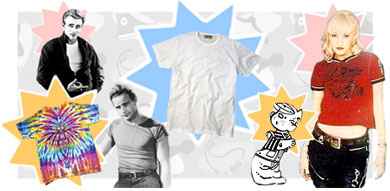T-shirts

Fashion Synopsis
The ubiquitous, all-American t-shirt was born at the beginning of the 20th century, spawned by the need of the U.S. Navy ‘to cover the chest hairs of their salty dogs’ when they went overboard. Who would have thought that such a simple need would spawn the most widely cherished and well-worn article of clothing? The t-shirt, in its many shapes, sizes and styles, is worn by young and old, rich and poor, fashionistas and fashion rebels alike: no other garment, including jeans, is worn more.
In 1930, Hanes marketed a simple white cotton undershirt that featured a rounded ‘crew’ neck, short sleeves and a waist length trunk. The knit construction made it easy to slip on and off the head, and the stretch made it a giving fit for all body types. The first Hanes undershirt for civilian men hit the shelves priced at 24 cents apiece. This garment represented the modern conveniences of fabrics in a wash and wear knit cotton, and became increasingly more acceptable as a casual wear shirt inside the house, but never out of it.
During WWII, the future tee became known as the skivvy shirt, a regulation issue undershirt for all GI’s, not just Navy men. The shape of the shirt lying flat was that of a ‘T,’ hence its new nickname. The t-shirt became a popular leisure time wardrobe for the GI’s, but only when in serving humid regions, and only in the company of buddies in a casual environment. It was still not acceptable outerwear at this point, and gallivanting about in your skivvy shirt was considered almost as obscene as walking around in your drawers.
Back on the homefront, mothers demanded the easy wash and wear fabric of the Hanes undershirt for their children, and the first ‘fashion’ tee was produced in colorful horizontal stripes as playtime wear for the young’uns. This new shirt truly sparked the age of leisure: not only did the shirt free mom from ironing cotton oxford shirts, but the comfortable cotton knit allowed a freedom clothes had never experienced. The t-shirt was quickly pulled on and off, cleaned easily, and could stand up to a lot of activity before it looked raggedy. Not even Dennis the Menace could destroy it, his striped t-shirt remaining a constant uniform as he wreaked havoc in the neighborhood.
Even though kids were enjoying the comforts of their t-shirts, the plain white tee remained strictly an undershirt for men until Marlon Brando strutted his bulging biceps in an outerwear t-shirt in the 1947 play and 1951 movie A Streetcar Named Desire. Brando did it again in the 1954 film The Wild One, and when a young James Dean adopted the shirt in 1955’s Rebel Without a Cause, every teenage boy in America wanted to emulate his rebel heroes, adopting the plain white tee as a uniform. The t-shirt became a staple, worn under leather jackets or alone. Sleeves were rolled up to show off biceps and tattoos, as well as to offer a convenient and cool storage place for packs of cigarettes.
The t-shirt was put back under cover during the highly styled 60’s, until at the end of the decade, the hippies returned the cotton shirt to the forefront. A new process called ‘tie-dye’ altered the plain white cotton tee into an explosion of colorful bursts, and the tee was never the same. Girls were now officially wearing the cotton knit tee, and when the 70’s turned unisex, the t-shirt became a part of everyday life for everybody.
By this time, the tee was no longer just a ‘T’ shape. It cut off its sleeves and became a tank top and a muscle tee, cut off the bottom to become a belly shirt, colored sleeves and cuffs to become the ringer tee, and plastered itself with slogans via iron-ons and decals. People of all ages and walks of life adopted some variation of the cotton knit shirt for their leisure time wardrobe.
The 80’s continued the walking billboard phenomenon of the decal, and the t-shirt got logoized when clothing companies advertised that this simple cotton shirt (and its wearer) belonged to them. Coca-Cola, Vision Skatewear, Nike, Body Glove…everyone publicized their brand loyalty front and center. T-shirts even moved from casual wear to dressy with the advent of designer names and designer prices. Once Miami Vice made t-shirts acceptable wear underneath expensive Italian suits, a simple tee could now cost $100 or more.
The 90’s expanded the t-shirt into triple the normal size when grunge slammed the tee shirt into XXXL oversize. That decade also parodied popular logos with the over-the-top, brightly colored rave scene: Rice Krispies became Nice Tripsies, FedEx became FedUp, and so on. T-shirts were just an extension of how you felt, and your quote or parody spoke so that you didn’t have to. By the end of the 90’s, girls’ tees shrank down into ‘baby’ size, with tight, fitted sleeves and cropped waists.
So whether you’re a grandma with a picture patch of the grandkids, a corporate raider with your $80 Armani tee, or a young tyke wearing your favorite cartoon character, there’s a shirt out there for you. And you can guarantee that no matter where your family goes, all you’ll get is a lousy t-shirt for a souvenir.
Fashion Sub Categories
girl's apparelboy's apparel
